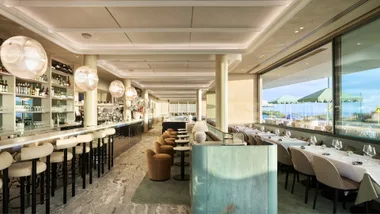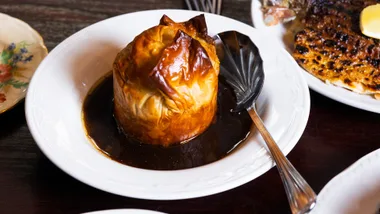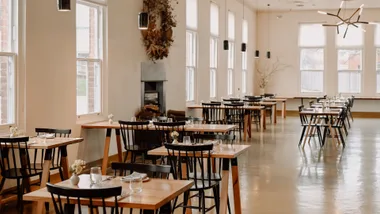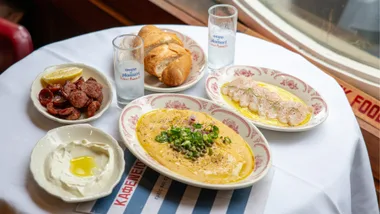A Tavola
348 Victoria St, Darlinghurst, NSW, (02) 9331 7871, www.atavola.com.au.
Dinner Mon-Sat, lunch Fri. Licensed and BYO. Major cards accepted.
Prices Entrées $12-$19, mains $22-$36, desserts $10-$15.
Noise Really depends on who you’re elbow-to-elbow with.
Vegetarian Salads, pasta specials, but not a solid vego offering.
Wheelchair access Not great.
Plus The Italian road-less-travelled; excellent fresh pasta.
Minus Forgettable desserts.
Walk past A Tavola in the afternoon and you’ll see boxes of produce and acres of different pasta shapes strewn over the long marble communal table that runs down to the open kitchen. The mirrors on one wall reflect the blackboard specials on the other. Call A Tavola (‘to the table’) and ask for a menu and you’ll be told the menu for each service is written only when the pasta is made and the day’s produce is all at the chef’s fingertips. The place opened in August 2007 on the Victoria Street site formerly occupied by Tasso (another Italian restaurant of some character), but already it’s a scene, and they’re doing three sittings on their brisker nights. The courtyard out the back – in the throes of renovation as we go to print – should go some way to accommodating the demand, but for now it looks like they’re making an offer Sydney can’t refuse.
This sort of interest straight out of the box for a largely unknown chef without any press to his name is a keen indication of how hard it is to get reliably good Italian food – even relatively simple stuff – for less than $30 a main course in the city. Bourke Street’s Il Baretto, still packed to this day, was massively oversubscribed in the early noughties thanks to its offer of excellent pasta made by the sadly departed Antonio Facchinetti for less than $25 a plate. Post-Facchinetti, that sort of package has been the Holy Grail for fanatical diners. A Tavola might be the next best thing.
Eugenio Maiale is the chef and owner. You might know him from his time at Woolloomooloo’s Manta under that restaurant’s stewardship from Steve Manfredi. His family are from Abruzzo and he grew up in Adelaide, where he opened Auge and Citrus, restaurants both of good repute, before moving to Sydney. At A Tavola, his focus is pasta, and admirably so. That fresh pasta constitutes half the blackboard menu. There’s also a small static printed menu, which features core classics made with pasta asciutta (literally, dried pasta, and he’s using Garofalo, a decent brand): bucatini Amatriciana, spaghetti alle vongole and sigarette (a tubular pasta of middling length) al ragù.
It’s not all spaghetti, though. For one thing, there’s the olives all’ Ascolana, those pork and veal-stuffed fat green olives that are deep-fried into beer-snack gold. Melbourne’s Becco makes the benchmark, and Danny Russo’s at Lo Studio were notable. Served here in a nest of rocket, they’re a must, though the baked olives with anchovy, hunks of pecorino Sardo and warm oil run interference. The offer of a dish of olive oil infused with sliced red chillies alongside the focaccia, meanwhile, is a nice touch.
The printed menu offers three other entrées and three salads. In practice and pricing, they seem pretty much interchangeable. The Swiss brown mushrooms with peas, mint and ricotta salata make for a fresh and pleasing combination of textures, while little dollops of Gorgonzola dolce latte enliven the salad of red cabbage, raisins and walnuts. Splashed with balsamic vinegar, the latter is maybe a shade sweet, but it’s otherwise dressed properly, and in that it’s a rare and beautiful thing.
There’s admirable simplicity in slices of Veneto salame (a smallish pork sausage) fried and paired with a nicely creamy polenta and a solid whack of parmesan. Over on the blackboard, the kingfish carpaccio with grapefruit and Campari dressing might sound like a surf ‘n’ turps experiment gone horribly awry, but is surprisingly good. Now that raw fish has broken the bonds of Japanese cuisine and found its way into pretty much every form of modern dining (okay, I’m yet to see the Germans go big on it), you see a lot of it absolutely swimming in acid, presumably to mask the fact that you’re eating raw fish. A Tavola’s kitchen, happily, seems to think that if it’s raw fish they wants, it’s raw fish they gets, and despite the vigour of the dressing, the fish is still there for the tasting, with a caper here and a parsley leaf there for interest.
To the pasta. Bucatini Amatriciana is a gutsy crimson guanciale-fuelled fun-fair, a three-punch takedown of tomato, the cured pork jowl Italians call guanciale, and chilli, with a dusting of Pecorino. House-made tagliarini with asparagus and truffle butter is less intense but still interesting. The pasta is fine, closely resembling angel hair. The young sprouts of asparagus have a similar delicacy, the heads whole but the stalks cut crosswise into tiny confetti. The truffle component is a truffle butter – its flavour is strong, if a bit one-dimensional, but I can live with it.
Then there’s the fettuccine. Its saucing – largely field mushrooms and porcini, with a dab of mascarpone for lubrication and body – isn’t radically different from a thousand less successful versions of the same dish you encounter in cafés across the country. Here, though, the mushrooms are sautéed and seasoned with enough care to render them genuinely flavoursome and meltingly gooey, a few broad swatches of Grana Padano laid across them. It’s the pasta that really sets it apart, however. It’s good, springy stuff that feels like it has some life in it, not to mention flavour. A revelation after the dead strips of ribbon that pass for fresh pasta in many less-skilled hands.
I didn’t try the pasta e fagioli, but I wanted to. I had only a mouthful of the stracci (rags of fresh pasta) with rabbit and green olive ragù. Its owner was loathe to part with more, and fairly so. But I did have the orecchiette (undoubtedly the pasta shape of the new millennium) with chicken livers and cime de rapa, and it’s the bomb, the business, the boo-ya, a two-fisted, no-nonsense blockbuster of a dish.
The cime di rapa – turnip tops, if you prefer – cut the chopped livers’ not inconsiderable richness, and the pan juices form all the sauce you’ll need. Other nights see the livers with stracci pasta and the orecchiette with a stirring rendition of the classic southern broccoli, chilli and anchovy sauce, winners all.
The regular menu offers three desserts: tiramisù, Vin Santo e biscotti and affogato. I was thrown to find some of the biscuits served for dipping with the Vin Santo covered with chocolate on one instance, and just not quite right on another. The tiramisù isn’t exciting, and the dessert specials I’ve hooked my spoon into – a meringue, pear and rhubarb rotolo with less-than-great meringue, say – haven’t been the sort of thing that would rock your world. They’re not bad, exactly – just seriously outclassed by the rest of the menu.
Speaking to Maiale later on the phone, he said he decided to open the restaurant because he found it hard to get a good plate of pasta in Sydney at a fair price. He wanted an enoteca where the menu was small and less meant more. “A simple, honest eating house,” he said, and you can’t ask for fairer than that. It’s not somewhere you’ll make a bee-line to for wine, and while one of our waitresses has been consistently lovely, service is looking overtaxed as the restaurant becomes ever busier. But the place looks good, has spirit, and, best of all, offers gutsy, genuine food.
“My mother and aunts taught me how to make pasta,” Maiale says. “My uncle would go out shooting for wild boar and we would be rolling out gnocchi or cavatelli, or maccheroni alla chitarra. He’d come back a bit later and we’d make a ragù in a huge bowl, and when it was ready, they’d cry a tavola, ‘to the table’, which is the whole idea.”
 Teny Aghamalian
Teny Aghamalian










